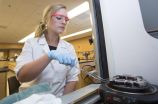(Press-News.org) New research suggests the use of hookah steam stones - commonly considered a safer alternative to cigarette smoking - could be leaving users with a dangerous, false sense of security. The findings out of the University of Cincinnati/Agilent Technologies Metallomics Center of the Americas are published this month in the Microchemical Journal.
An analysis led by Amberlie Clutterbuck, a doctoral student in the UC Department of Chemistry, found residues of toxic metals that included chromium, arsenic and cadmium following several simulated hookah/steam stones smoking scenarios.
Clutterbuck's research centered on a newer hookah trend involving so-called steam stones, where she analyzed the smoke produced from two different brands of steam stones that can be ordered online. The stones are placed in the bowl of the apparatus. "These pebble-like rocks are soaked in the same type of fluid used in various hookah tobaccos, such as mo'assel - popular in the USA (typically glycerin, but might include honey or molasses) - and heated in the heads of the hookah device in place of tobacco to create a smoke-like vapor cloud, plus small aerosol droplets," the authors write in the article.
Clutterbuck also tested different charcoal that is ordered by hookah users to heat the steam stones. She tested several 30-minute simulated smoking scenarios involving the different brands of steam stones and charcoal.
The analysis found that out of the different smoking scenarios involving the steam stones, there were statistically significant and similar amounts of chromium and arsenic inhaled, regardless of the brands of steam stones or charcoal that were used. Both of those chemical elements are human carcinogens if present in certain forms.
Clutterbuck's analyses also found that the toxic metals from the steam stones did not consistently travel through the hookah to the mouthpiece, so the study suggests that the majority of toxic metals that turned up in the mouthpiece likely came from the charcoal used to heat the apparatus. Those metals included varying amounts of chromium (Cr), nickel (Ni), copper (Cu), arsenic (As), cadmium (Cd) and lead (Pb) that were found on the filters.
"In spite of the claims that the steam stones are a 'safer' alternative tobacco product, this research demonstrates a smoker will still be subjected to toxic metals in potentially harmful amounts when using traditional charcoal," states the article.
Contributing authors on the journal article included Ryan Saadawi, a doctoral candidate in chemistry; Julio Landero-Figueroa, a UC research assistant professor; and Joseph Caruso, Clutterbuck's advisor and UC chemistry professor.
Hookah use is part of an emerging smoking alternative in the tobacco industry that's taking off in the United States and around the world. Hookah cafés are drawing primarily the college-age crowd to congregate around what's perceived as a safer alternative to cigarette smoking.
The practice involves heating a water pipe in the hookah to inhale vapors from tobacco that has been laced with a variety of different flavors. The Centers for Disease control describes the apparatus as containing a water bowl, body (a metal pipe of sorts), hose, head and mouthpiece, which is typically shared by smokers.
Many of the exotic-themed cafés reflect the origins of hookah smoking from centuries ago in countries like India and Persia.
In 2014, the Food and Drug Administration began taking action toward regulating newer tobacco products such as hookah use by proposing rules that industries register with the FDA and market only products following an FDA review.
Clutterbuck's research centers on an emerging field called metallomics, the study of the impact of metals on biological systems. In this investigation, Clutterbuck used an advanced chemistry instrument called the Agilent 8800 triple quadrupole ICPMS (ICP-QQQ) - an instrument used in atomic spectroscopy - to measure the levels of toxic metals that could result from a 30-minute smoking session using the steam stones.
The Agilent 8800 is a premier research tool housed in the University of Cincinnati/Agilent Technologies Metallomics Center of the Americas. The center, launched in 2007 in the UC Department of Chemistry, is a partnership between UC and Agilent Technologies that emphasizes UC's state-of-the-art partnerships merging research with industry. The partnership links UC with researchers around the world as they examine the effects of metals on biological systems. UC Chemistry Professor Joseph Caruso calls the center the first of its kind in the world.
INFORMATION:
The UC Department of Chemistry conducts scholarship and research in a variety of pioneering areas including drug design and delivery; green chemistry; chemical and biochemical sensors; and biophysical methods.
Philadelphia, PA, May 11, 2015 -- Dopamine is the chemical messenger in the brain most closely associated with pleasure and reward. Recent scientific advances now shed light on precise roles for dopamine in the reward process.
A new paper published in the current issue of Biological Psychiatry implicates dopamine in a person's ability to be motivated by delayed rewards.
People like immediate reinforcement and tend to devalue rewards that are substantially delayed in time. As a result, people will often opt for smaller immediate rewards as opposed to larger delayed rewards ...
Even with the best available treatments, the median survival of patients with metastatic, hormone-refractory prostate cancer is only two to three years. Driven by the need for more effective therapies for these patients, researchers at VCU Massey Cancer Center and the VCU Institute of Molecular Medicine (VIMM) have developed a unique approach that uses microscopic gas bubbles to deliver directly to the cancer a viral gene therapy in combination with an experimental drug that targets a specific gene driving the cancer's growth.
Recently published in the journal Oncotarget, ...
CORVALLIS, Ore. - Scientists at Oregon State University have developed a faster, more accurate method to assess cancer risk from certain common environmental pollutants.
Researchers found that they could analyze the immediate genetic responses of the skin cells of exposed mice and apply statistical approaches to determine whether or not those cells would eventually become cancerous.
The study focused on an important class of pollutants known as polycyclic aromatic hydrocarbons, or PAHs, that commonly occur in the environment as mixtures such as diesel exhaust and cigarette ...
Swollen lymph nodes are often the earliest sign of metastatic spread of cancer cells. Now cancer researchers and immunologists at Sweden's Karolinska Institutet have discovered how cancer cells can infiltrate the lymphatic system by 'disguising' themselves as immune cells (white blood cells). The researchers hope that this finding, which is published in the scientific journal Oncogene, will inform the development of new drugs.
The main reason why people die of cancer is that the cancer cells spread to form daughter tumours, or metastases, in vital organs, such as the ...
COLUMBUS, Ohio - A study by researchers at The Ohio State University Wexner Medical Center found that a workplace mindfulness-based intervention reduced stress levels of employees exposed to a highly stressful occupational environment.
Members of a surgical intensive care unit at the large academic medical center were randomized to a stress-reduction intervention or a control group. The 8-week group mindfulness-based intervention included mindfulness, gentle stretching, yoga, meditation and music conducted in the workplace. Psychological and biological markers of stress ...
Individuals who had cancer as a child may be at increased risk of being obese due to the therapies they received during their youth. The finding comes from a new study published early online in CANCER, a peer-reviewed journal of the American Cancer Society. The study's results suggest the need for effective counseling and weight loss interventions for certain childhood cancer survivors.
Previous research has shown that obesity rates are elevated in childhood cancer survivors who were exposed to cranial radiation, which is used to prevent or delay the spread of cancer ...
Patients with advanced colorectal tumors without mutations in the RAS genes derive substantial benefit from anti-EGFR therapies; however, the disease eventually progresses, leaving these patients with few alternative therapeutic options. Over the last decade, some of the mechanisms driving resistance have been identified, but despite intensive research, treatment options available for patients have not improved, Tabernero said.
Sym004 is a 1:1 mixture in the same infusion bag of two antibodies that bind to different regions of the extracellular domain of EGFR, according ...
The world's first international study on homophobia in sport, "Out on the Fields," has found widespread homophobia in UK sport, prompting calls for a zero tolerance approach towards discrimination and better training for coaches, teachers and officials.
The research, on behalf of the Bingham Cup (the world cup of gay rugby) and affiliated sports groups, was conducted by the global sports market research firm Repucom and overseen by a panel of seven academics from six universities, including Brunel University London.
Participants were from the United Kingdom, Ireland, ...
Sea scallops, one of the most valuable commercial fisheries in the United States, are a well managed and monitored fishery, yet little is known about how changing ocean temperatures and ocean chemistry and other environmental factors could impact the fishery. A new study published May 6 in PLOS ONE describes a new computer model to help inform scallop management discussions and decisions in the coming decades.
Researchers from the Woods Hole Oceanographic Institution (WHOI), NOAA Fisheries' Northeast Fisheries Science Center (NEFSC), and Ocean Conservancy developed an ...
BINGHAMTON, NY -According to new research co-authored by Binghamton University's Seth Spain, there is more than meets the eye when it comes to the impact of Saturday morning cartoons.
The research examines how fantasy-based stories, in particular the popular 1980s cartoon series The Transformers, can shape children's perceptions of what behaviors are associated with effective leadership. It also could provide a basis for workplace-training programs.
"We believe that Transformers presents three key lessons about leadership," said Spain, an assistant professor of organizational ...



